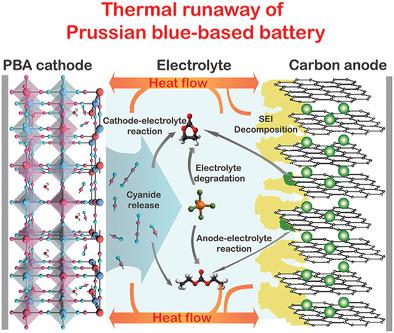当前位置:
X-MOL 学术
›
Adv. Energy Mater.
›
论文详情
Our official English website, www.x-mol.net, welcomes your
feedback! (Note: you will need to create a separate account there.)
Revealing the Thermal Safety of Prussian Blue Cathode for Safer Nonaqueous Batteries
Advanced Energy Materials ( IF 24.4 ) Pub Date : 2021-10-05 , DOI: 10.1002/aenm.202101764 Zheng Li 1 , Mehran Dadsetan 2 , Junxian Gao 1 , Sensen Zhang 1 , Lirong Cai 1 , Ali Naseri 2 , Martha E. Jimenez‐Castaneda 3 , Timothy Filley 3 , Jeffrey T. Miller 1 , Murray J. Thomson 2 , Vilas G. Pol 1
Advanced Energy Materials ( IF 24.4 ) Pub Date : 2021-10-05 , DOI: 10.1002/aenm.202101764 Zheng Li 1 , Mehran Dadsetan 2 , Junxian Gao 1 , Sensen Zhang 1 , Lirong Cai 1 , Ali Naseri 2 , Martha E. Jimenez‐Castaneda 3 , Timothy Filley 3 , Jeffrey T. Miller 1 , Murray J. Thomson 2 , Vilas G. Pol 1
Affiliation

|
Prussian blue analogs (PBAs) are promising cathode materials for many next-generation metal-ion batteries due to their exceptional electrochemical performance. Their oxygen-free structure avoids a common battery thermal runaway pathway which requires O2 liberation. Herein, the thermal runaway mechanisms of PBAs are studied from the level of material and full cell in nonaqueous sodium- and potassium-ion batteries (SIBs and KIBs). Their hidden safety issue and a novel runaway mechanism that requires no oxygen evolution are identified. The cyanide groups are released (≈51.4 wt%) as toxic cyanides above 200 °C, which also exothermically react with the electrolyte and cause the runaway. The cyanide gas generation mechanism is proposed as cathode hydrolytic disproportionation by Raman spectroscopy, X-ray photoelectron spectroscopy, in situ environmental transmission electron microscopy, and operando synchrotron X-ray diffraction studies. In addition, full-cell level calorimetric studies reveal mitigated heat generation but lower initiation temperature of runaway from such SIBs and KIBs than conventional LiCoO2–graphite system. These results change how PBA materials are evaluated from a safety standpoint, suggesting that they cannot be regarded as safe cathodes. They also indicate the correlations between thermal safety and their crystal defects or trapped water content. The proposed thermal runaway mechanism provides insights to assist in the building of safer next-generation batteries.
中文翻译:

揭示普鲁士蓝阴极的热安全性,可用于更安全的非水电池
普鲁士蓝类似物 (PBA) 因其卓越的电化学性能而成为许多下一代金属离子电池的有前途的阴极材料。它们的无氧结构避免了需要 O 2的常见电池热失控途径解放。在此,从非水钠离子和钾离子电池(SIBs 和 KIBs)的材料和全电池水平研究 PBAs 的热失控机制。确定了它们隐藏的安全问题和不需要氧气析出的新型失控机制。氰化物基团在 200 °C 以上以有毒氰化物形式释放 (≈51.4 wt%),也会与电解质发生放热反应并导致失控。通过拉曼光谱、X 射线光电子能谱、原位环境透射电子显微镜和原位同步加速器 X 射线衍射研究,氰化物气体产生机制被提出为阴极水解歧化。此外,2——石墨系统。这些结果改变了从安全角度评估 PBA 材料的方式,表明它们不能被视为安全正极。它们还表明了热安全性与其晶体缺陷或截留水含量之间的相关性。拟议的热失控机制提供了有助于构建更安全的下一代电池的见解。
更新日期:2021-11-11
中文翻译:

揭示普鲁士蓝阴极的热安全性,可用于更安全的非水电池
普鲁士蓝类似物 (PBA) 因其卓越的电化学性能而成为许多下一代金属离子电池的有前途的阴极材料。它们的无氧结构避免了需要 O 2的常见电池热失控途径解放。在此,从非水钠离子和钾离子电池(SIBs 和 KIBs)的材料和全电池水平研究 PBAs 的热失控机制。确定了它们隐藏的安全问题和不需要氧气析出的新型失控机制。氰化物基团在 200 °C 以上以有毒氰化物形式释放 (≈51.4 wt%),也会与电解质发生放热反应并导致失控。通过拉曼光谱、X 射线光电子能谱、原位环境透射电子显微镜和原位同步加速器 X 射线衍射研究,氰化物气体产生机制被提出为阴极水解歧化。此外,2——石墨系统。这些结果改变了从安全角度评估 PBA 材料的方式,表明它们不能被视为安全正极。它们还表明了热安全性与其晶体缺陷或截留水含量之间的相关性。拟议的热失控机制提供了有助于构建更安全的下一代电池的见解。











































 京公网安备 11010802027423号
京公网安备 11010802027423号